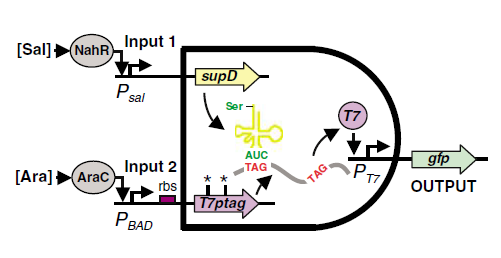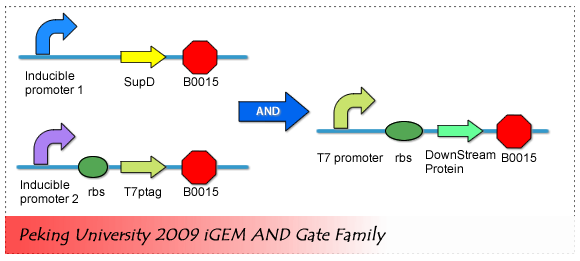Mechanism
Many AND Gate have been designed and constructed in the past years. In our project, We adopted the design of Christopher Voigt, Which is published on Molecular Systems Biology.
 fig1. The mechanism of the AND Gate J Christopher Anderson, Christopher A Voigt and Adam P Arkin (2007) Environmental signal integration by a modular AND gate Molecular Systems Biology 3:133Fig.1 illustrates the mechanism of the design. One of the inputs of the and gate leads to the expression of T7ptag mRNA which is a T7 polymerase coding sequence with amber mutations inside. The other input of the And gate leads to the expression of supD tRNA, which is a amber mutation suppressor. The concurrence of the mRNA and the tRNA can make functional T7 polymerase, which can activate the downstream T7 promoter.
The AND Gate can be further decoupled into a input interface, a core, and a output interface.
 fig2. AND Gate Biological ComponentsThe input interface includes two inducible promoter which can be induced to expression by two different environmental small molecules. Core of the AND Gate is the T7 polymerase coding sequence with amber mutations and supD tRNA. And the Output interface is actually a T7 promoter, which regulate the expression of the downstream component.
Sensor System (The input interface)
The input interface includes two inducible promoter which can be induced to expression by two different environmental small molecules.
We actually prepared five inducible promoter, and make combinations among the five promoters. The five promoters are tetR repressible promoter inducible by aTc, PBad promoter by arabinose, Lac Promoter inducible by IPTG, Salicylate inducible promoter and Lux promoter that responses to HomoSerine Lactone.
All of these inducible promoters can only work in the presence of activators or repressors, so we cloned all the activators and the repressors downstream of a constitutive promoter to make a protein generator. Then the generator is placed upstream of the corresponding inducible promoter.
There are two ways, actually, to put the generator upstream of the inducible promoter.
As shown in fig3.
1. The constitutive promoter is cloned back to back with the inducible promoter, thus transcription of the activator or the repressor is opposite of the inducible promoter. 2. The generator transcripts in the same direction of the inducible promoter, the constitutive promoter is prevented to interfere with the inducible promoter by the terminator. However, any terminator is leaky, the first way is the better way to prevent interference.
This construct combines repressors (activators) together with its promoter. It is actually a quite useful part even outside of the AND gate Module. We call it an environmental small molecule sensor. It provides a sensor for environmental signals and a interface to intracellular circuits. Actually, a similar construct(repressor protein only) without the constitutive promoter is called an inverter, but we think it is more proper to be called a sensor when the promoter upstream of the repressor is a constitutive promoter. Its signaling molecule like aTc, IPTG, arabinose, HomoSerineLactone and salicylate diffuse into the cell and take function. It is like the some of the hydrophobic hormones in high organisms.
The promoters we chose at first is the LuxR-LuxP construct induced by Homoserinelactone, the tet operon induced by aTc, the Lac operon induced by IPTG, and the Arabinose inducible promoter PBad. So we designed the following sensors:
^Top
|